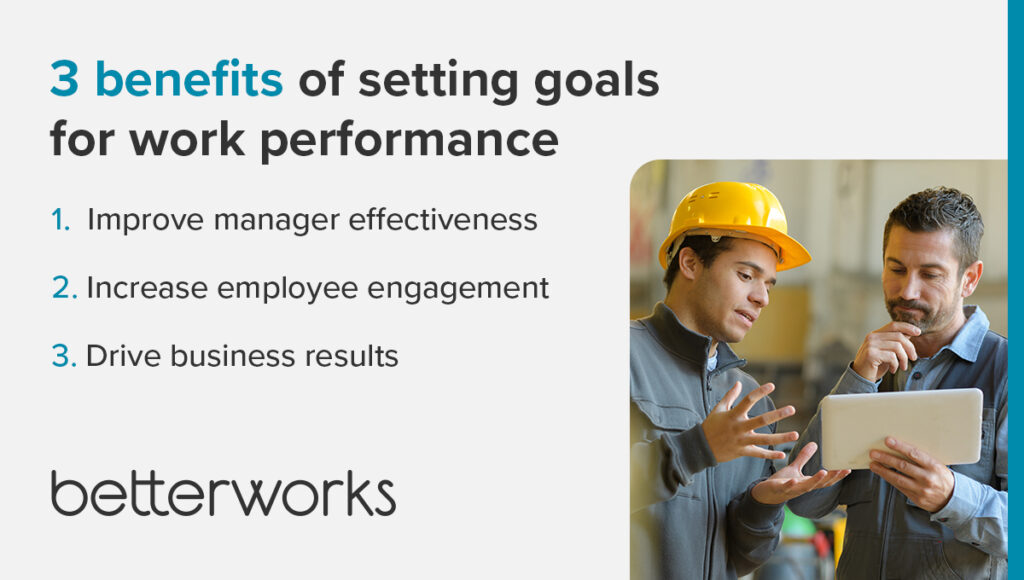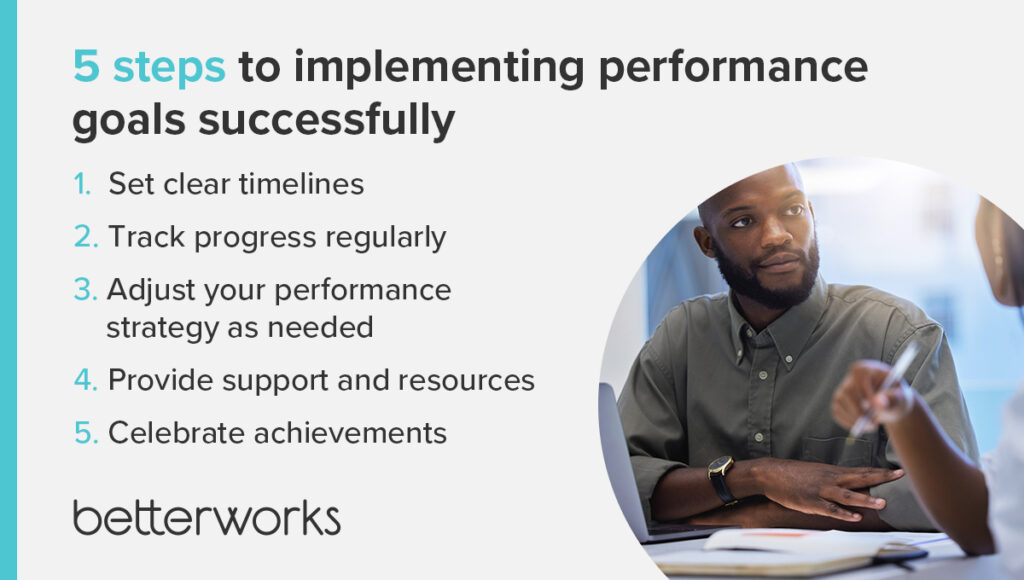Achieving business success requires your entire workforce to work together toward shared strategic goals — and one of the best ways to make sure every team and team member is pulling in the right direction is by setting clear, actionable employee performance goals.
Effective goals not only guide daily tasks but also bridge individual aspirations with organizational objectives. “What is the connection between what the employee wants to do and how it will serve the department or the organization?” asks Caitlin Collins, organizational psychologist and program strategy director at Betterworks.
While effective goals are hard to set, looking at a range of employee performance goal examples across diverse roles and industries can provide a useful model. Discover some employee performance goal examples to inspire you to craft performance goals that truly make a difference.
6 elements of a good performance goal
As an HR leader, crafting effective performance goals is crucial for driving your team’s success and aligning individual efforts with organizational objectives. We’ve all heard of the SMART performance goals framework, which represents goals that are specific, measurable, achievable, relevant, and time-bound. But SMART performance goals aren’t the only model to follow when setting goals.
The best performance goals align each employee’s personal strengths and passions with opportunities to drive business results. “What are they really good at?” Caitlin asks. “If they have an interest in something, how do I help support them and find opportunities to really drive those interests forward?”
Check out some key elements of good, high-impact performance goals and OKRs to help employees grow alongside the business.
Aligned with company values
A good performance goal reflects the core values and mission of your organization. When goals resonate with what the company stands for, they help create a cohesive work culture and ensure that everyone is working toward a common purpose. This alignment also fosters a deeper sense of commitment and pride among employees. When you align goals with company values, you reinforce the right behaviors that drive the organization forward.
Autonomous
When it comes to effective goal-setting, choice matters. “Give people a chance to choose something that has meaning to them,” Caitlin says. “If we assign goals to people, they don’t mean as much and people won’t really care about them.”
Autonomy in goal-setting empowers employees to choose personally meaningful objectives, leading to higher engagement and motivation. By giving team members ownership over their goals, organizations can drive intrinsic motivation and foster a more committed, high-performing workforce.
Clear and concise
Clarity is crucial when setting performance goals. Good goals are articulated in simple and straightforward language. Clear goals minimize confusion, reduce misunderstandings, and provide a solid foundation for performance discussions and feedback. Clear and concise goals help employees carry out their job responsibilities and experience success.
Challenging yet realistic
Effective performance goals should push employees to stretch their abilities without setting them up for failure. Striking the right balance between challenge and attainability keeps your team motivated and engaged. Goals that are too easy can lead to complacency, while overly ambitious ones can cause frustration and burnout.
The secret is finding that sweet spot where employees feel challenged but not overwhelmed. This approach to setting goals with a stretch component encourages employees to strive for excellence while feeling supported.
Actionable
Performance goals should outline specific actions that employees need to take to achieve them. Providing a clear roadmap of tasks and activities helps employees focus their efforts and resources effectively. Actionable goals empower employees by giving them a clear path to follow, making it easier for employees and their managers to stay up to date with their progress and make the necessary adjustments.
Provide access to goal-setting examples for employees so they can see what goes into a good, actionable goal.
Feedback-oriented
A strong performance goal is one that can be adjusted to reflect changing organizational and team needs. There should also be a component of feedback to help employees stay on track and make any necessary adjustments to their strategies and efforts.
By fostering an environment where feedback is valued and incorporated, you ensure that goals remain dynamic and relevant. Feedback doesn’t always have to be big. “Those might just be little nudges, things that people can be mindful of to help them improve in small ways that lead to big outcomes,” Caitlin says.
Regular check-ins and feedback are essential. They help ensure that employees aren’t just meeting their performance goals, but also their professional development goals, such as developing their communication skills or leadership skills.

3 benefits of setting goals for work performance
As an HR leader, you’re always looking for ways to enhance your team’s productivity and engagement — and you can’t overlook the importance of setting goals in driving business outcomes. Setting clear, measurable goals for work performance is one of the most effective strategies for driving results.
Here are three key benefits of implementing goal-setting practices in your organization, backed by the latest research.
Improve manager effectiveness
Setting performance goals can significantly enhance manager effectiveness. When managers have specific targets to guide their actions, it becomes easier for them to allocate resources, prioritize tasks, and make informed decisions. Clear goals also foster better communication between managers and employees, ensuring everyone is aligned and working toward common objectives.
According to Betterworks’ 2024 State of Performance Enablement report, employees are 31% more likely to feel productive when performance management processes are viewed as successful. This shows how critical it is for managers to have structured, goal-oriented approaches to lead their teams effectively.
When managers can monitor progress toward clear goals, they can provide more consistent feedback and support, ultimately leading to a more engaged and productive workforce.
Increase employee engagement
Employee engagement is crucial for maintaining a motivated and committed workforce. By setting clear performance goals, employees gain a sense of direction and purpose in their roles. They understand how their individual contributions align with the broader organizational objectives, which increases their motivation to perform well.
The Betterworks report highlights that employees who view performance management processes as successful are significantly more likely to feel engaged and see a path for advancement within the company. This sense of alignment and purpose not only boosts engagement but can also help with retaining top talent. When employees are involved in the goal-setting process, they feel valued and empowered, leading to higher job satisfaction and overall performance.
Drive business results
The ultimate benefit of setting performance goals is the positive impact on business results. Clear, well-defined goals align individual and team efforts with the organization’s strategic objectives, making sure that everyone is working toward the same outcomes. This alignment helps streamline operations and fosters a culture of accountability and continuous improvement.
The Betterworks report underscores that organizations with robust goal-setting frameworks are more likely to achieve high performance. Specifically, employees who feel their performance management processes are successful are more productive and optimistic about their work. When you set employee performance goals, you create a clear pathway for success, enabling you to track progress, celebrate milestones, and make data-driven decisions.

15 examples of performance goals
Whether you’re looking to enhance productivity, boost employee engagement, or drive business results, having well-defined employee performance goals can make all the difference. To help you get started, here are some practical examples of goals for employees that cover various aspects of business operations. These examples of employee performance goals are designed to be specific, actionable, and aligned with your organizational objectives, ensuring your team stays focused and motivated.
Incorporating work performance goal examples into your performance management strategy will help clarify expectations and empower your employees to take ownership of their roles and strive for excellence. Let’s dive into some hypothetical examples of goals for employees that you can adapt and implement in your organization.
1. Call center representative
Goal: Deliver stellar customer service by developing new process for inbound customer calls by end of March
As measured by:
- Meet with co-workers to identify 10 pain points or inefficiencies by end of January
- Review the 20 calls that took the most time to assist customers by end of January
- Present new process to manager by end of March
2. Head of customer success
Goal: Exceed our renewal target in preparation for fundraising in Q2
As measured by:
- Achieve 90%+ renewal rate by end of Q1
- Ensure 40% of renewals are multi-year contracts
- Confirm each Customer Success Manager has a renewal plan for their top 10 customers by end of January (70 plans)
- Conduct a business value assessment with top 50 customers by February 5
3. Product designer
Goal: Ensure a wildly successful product launch by end of March
As measured by:
- Participate in 5 user interviews with user researcher to assess user challenges and needs by January 10
- Meet with lead software engineer and QA engineer to discuss design, iterations, localization QA and bug testing before February 15
- Create and present 5 prototypes to head of design by March 5
- Deliver interaction visual designs to product and engineering by March 15
4. Chief financial officer
Goal: Set us on the right track with 3-year strategic plan by December 20
As measured by:
- Meet with 10 departmental stakeholders by October 20
- Set revenue targets with VP of Sales by November 17
- Approve company-wide hiring plan by November 30
- Receive approval on strategic plan from the executive team and board by December 10
5. Legal counsel
Goal: Transform the contracts process to improve Sales efficiency and shorten time-to-close by 15% by the end of March
As measured by:
- Select a third-party contract management system by January 25
- Team training delivered on new playbook on contract negotiations by February 15
- Hire and onboard a new legal operations associate by end of March
6. Product marketing associate
Goal: Drive an epic launch for product v3.0
As measured by:
- Get 10,000 page impressions/downloads within first month of launch
- Create demo videos for sales that receive 1,000 views
- Create one customer case study or 3 testimonials supporting the product v3.0 value propositions by February 15
7. HR manager
Goal: Launch a new employee engagement program by end of March
As measured by:
- Send employee engagement survey by January 15
- Present a strategy for increasing employee engagement by February 20
- Execute quarterly employee event by end of March
8. Product manager
Goal: Increase cross-functional transparency into product KPIs by Q4
As measured by:
- Hold 3 monthly meetings with key stakeholders from marketing, engineering, and sales on product KPIs
- Develop a product KPI dashboard, partnering with the analytics team
- Ensure that 100% of Q3 product features have robust success metrics associated with them
- Confirm the lifetime value of the average product user vs. the average premium subscriber
9. Account executive
Goal: Build discipline around lead and opportunity management
As measured by:
- Maintain 100% of opportunities that are not older than 60 days
- Convert or downgrade all leads within 14 days
- Meet with 75 new opportunities by the end of Q14.
- Document 50 new discoveries in SFDC for Q1
10. Customer support representative
Goal: Grow and acquire necessary skills to advance through the support team over the next 6 months
As measured by:
- Surface 2 pieces of constructive feedback for the team each week
- Find a mentor external to the company and meet with them 2 times by the end of Q1
- Hold weekly 1:1s with new support intern to improve managerial skills
11. Healthcare recruiter
Goal: Recruit world-class health professionals to enhance levels of access, safety, and quality care
As measured by:
- Interview at least 20 applicants for new surgeon openings
- Identify and integrate the three top-performing referral medical groups into our system
- Increase professional development participation by 5 CEUs per quarter
12. Head of marketing
Goal: Create a foundation for solidifying brand and position as THE market leader
As measured by:
- Create a unified comms calendar across content, social, press, and launch activities by end of Q1
- Hire a new branding agency by end of Q1
- Set up 3 analyst briefings and manage analyst requests and submissions by end of Q1
- Get 8 media placements and 3 speaking opportunities by end of Q1
13. HR business partner
Goal: Develop succession planning program by end of March to drive up retention by 50% over 3 years
As measured by:
- Identify all high performers by January 25
- Create plans to retain each high performer by February 20
- Develop onboarding program for new managers to shorten time to ramp by 50% and improve employee experience by March 15
14. Executive administrator
Goal: Strengthen team culture in Q1
As measured by:
- Plan and execute Q1 quarterly event with 90% attendance
- Announce 8 award winners for company values by end of Q1
- Increase membership in “culture club” Slack channel from 45 to 90
- Plan 3 monthly happy hours in Q1
15. VP of Engineering
Goal: Ensure that release is delivered on time with high quality
As measured by:
- Have engineering team contribute 200 story points by end of March/Sprint
- Complete data migration by end of March/Sprint
- Have engineering team contribute 750 code review points by end of March/Sprint
- Add 100 automated front-end tests by end of March/Sprint
4 ways to customize goals to fit your team dynamics
To set employee performance goals that make a difference, one size does not fit all. Every team is unique, with its own set of dynamics, industry requirements, and corporate culture. To ensure your performance goals are effective, it’s essential to tailor them to fit your specific team’s needs.
Understand your team members’ strengths and weaknesses
Start by assessing your team’s current capabilities, areas for improvement, and unique make-up. This will help managers and team members collaborate to set realistic and achievable goals that play to their strengths while addressing any weaknesses. For instance, if your team excels in innovation but struggles with meeting deadlines, you might help team members identify goals that encourage creative thinking while also emphasizing time management.
Bring team diversity to bear when setting goals — especially cognitive diversity. To set goals that solve business challenges, you need as many perspectives and viewpoints weighing in as possible.
“Any complex problem requires the breadth of thinking teams can provide with solutions that address analytical, practical, relational, and experimental problems,” says Ann Herrmann-Nehdi, chair of the board and chief thought leader at Herrmann. “For that to happen, each team member needs to understand and leverage the different thinking they each bring so that together their collective intelligence provides the best possible solution.”
Align goals with industry standards
Different industries have different benchmarks for success. Ensure that your goals are relevant to your industry by incorporating industry standards and best practices. For example, sales teams might focus on targets like increasing conversion rates, while customer service teams might aim to improve response times and customer satisfaction scores.
Consider your corporate culture
Your company’s values and culture should be reflected in your performance goals. If your organization values collaboration, set goals that encourage teamwork and collective achievements. Conversely, if individual achievement is more highly prized, focus on personal performance metrics.
Adapt performance goals to your team’s size
The size of your team can also influence the type of goals you set. In smaller teams, the collaboration process can be more direct and personal. Managers and team members can engage in detailed discussions to align on goals, ensuring that individual objectives are well-integrated with team objectives.
With larger teams, the complexity increases. It becomes more challenging to ensure every team member’s voice is heard. Managers need to employ structured methods, like breakout sessions or surveys, to gather input effectively.
5 steps to implementing performance goals successfully
Setting performance goals is only half the battle. To truly drive success, you need to implement these goals effectively within your teams. Discover five steps to making sure your goals are not just set, but achieved.
Set clear timelines
Timelines are crucial for maintaining momentum and ensuring progress. Establish clear deadlines for each goal, whether they are short-term or long-term. This creates a sense of urgency and helps prioritize tasks. For example, if a goal is to improve customer satisfaction by 10% in six months, break this down into monthly milestones to track progress.
Track progress regularly
Regular monitoring is essential to keep goals on track. Schedule frequent check-ins to track performance goals, review progress, address any challenges, and provide feedback. This helps keep everyone accountable and allows for timely adjustments. Use performance tracking tools to streamline this process and provide real-time insights.
Adjust your performance strategy as needed
Flexibility is key to successful goal achievement. Be prepared to adjust your strategies based on ongoing feedback and performance data. If a particular approach isn’t working, or the impact of goal-setting isn’t what you expected, don’t be afraid to pivot and try something new. Encourage your team to share their insights and collaborate on finding solutions.
Provide support and resources
Make sure your team has the necessary resources and support to achieve their goals. This might include training, additional tools, or reallocating responsibilities. Providing the right support demonstrates your commitment to their success and empowers them to perform at their best.
Team leaders play an especially important role in helping employees drive bigger-picture goals. “If I’m a manager or a leader, how I manage and lead my team with goals, or how I coach them, should be a component of it as well,” Caitlin says.
Training managers to use performance goals as a coaching and leadership tool involves equipping them with strategies to align individual objectives with organizational goals and providing them with techniques to offer constructive feedback and support. By integrating goal-setting into their coaching practices, managers can inspire and guide their teams toward achieving greater performance and development.
Celebrate achievements
Recognizing and celebrating achievements, no matter how small, can boost morale and motivation. When a goal is met, acknowledge the hard work and effort that went into achieving it. This not only reinforces positive behavior but also encourages a continued commitment to goal-setting and achievement.

How Betterworks helps you achieve performance goals
As you work towards setting and implementing effective performance goals, having the right tools can make all the difference. Betterworks offers a comprehensive solution designed to streamline the entire goal management process. With its intuitive platform, you can set clear, aligned goals that resonate with your company’s strategic objectives, track progress in real time, and facilitate continuous feedback and adjustments.
Betterworks empowers employees with self-service tools to manage and track performance goals, fostering a sense of ownership and engagement. This continuous dialogue and transparency help keep everyone accountable and motivated, ensuring that goals remain relevant and achievable. By leveraging Betterworks, you can create a high-performing team that consistently meets and exceeds expectations, driving sustained success for your organization.
Start today by setting clear, actionable goals and see how this simple yet powerful practice can transform your organization. With the right approach and tools, you’re well on your way to achieving your strategic objectives and driving sustained success.
Want to learn more? Check out some goal examples for every department.






